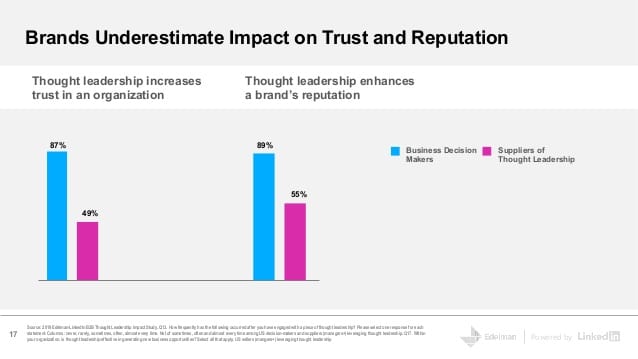Thought leadership is still a trending term in the business world – and for good reasons. It is a way of demonstrating mastery in a particular field or industry, and it can help to differentiate a company or individual from competitors.
Thought leadership involves deep analysis, research, and understanding of the subject matter, as well as the ability to effectively communicate those ideas to an audience. Unfortunately, this simply isn’t the case for most thought leadership content on the web.
According to this B2B Thought Leadership Impact Study by LinkedIn and Edelman, almost two-thirds (71%) of management-level professionals believe that less than half of the thought leadership content they consume provides any value to them.
That’s because many self-proclaimed thought leaders fall into the trap of merely sharing their thoughts on the subject matter without any real substance, research, or knowledge.
So, what is thought leadership, and what should it never be?
Let’s start with the basics.
Key Takeaways
- Thought leadership is far more than just sharing your thoughts. To make your content valuable, you must back up your ideas with research and real-world examples.
- Thought leaders invest time in researching and presenting information to assist their audience in understanding the topic. They share comprehensive information, not just information that serves their personal interests.
- Thought leadership requires authenticity and transparency to resonate with your audience.
What Is Thought Leadership?
When most people think of thought leadership, they picture a subject matter expert addressing a large audience, whether at a conference, a dinner, or on television.
While that’s a good thought leadership example, the concept of a thought leader has evolved significantly in recent years to include authors and experts who show up consistently to educate their audience.
Thought leadership today is about providing valuable insights and establishing yourself as a trustworthy resource with insights backed up by data and real-world examples. This is why nearly 65% of businesses try to incorporate it into their content marketing strategy.

A thought leader is something many business professionals strive to be. It sets you apart from the rest and can increase lead generation, brand loyalty, and sales. But to be perceived as a thought leader, you need to know what traits to exhibit to build trust and credibility.

Source: LinkedIn-Edelman via Marketing Insider Group
Traits of a Thought Leader
A genuine thought leader not only possesses extensive knowledge in their field but can also back up their expertise with proof and facts.
This individual cares enough about their field to spend time researching and presenting information that will help their readers understand the topic. Thought leaders share all relevant information, not just selective information that serves their personal interests.
Some important traits of a thought leader include the following:
- Determined: As a thought leader, you must be determined to find solutions to your audience’s problems, even when you don’t have all the answers. It also means that you aren’t afraid to take calculated risks and fail to find solutions.
- Humble: A genuine thought leader doesn’t claim to be a thought leader. These individuals share their knowledge and experience with the world and aren’t afraid to point their audience to other sources that may better serve them.
- Influential: Thought leaders can inspire others to follow their example and become leaders themselves. They can also make real connections with their audience and other thought leaders, and these relationships can be leveraged to build credibility and trust.
- Transparent: Thought leaders don’t just walk the walk, but talk the talk. They’re honest and upfront with their readers. They don’t deceive their audience by claiming to be the best. Instead, they strive to create a helpful and engaging support system for their potential customers.
- Customer-Centric: Thought leaders don’t just promote themselves or what their company sells. They seek to educate their audience on the biggest questions. For example, how this unified communications company tried to explain the larger meaning of its software category.
What Thought Leadership Should Never Be
Thought leadership is a valuable asset for any organization, as it allows them to stay ahead of the curve and provide innovative solutions to their industry’s challenges. However, thought leadership should never be used as a tool for self-promotion or to gain attention. Thought leaders should always strive to provide ideas and insights that benefit the industry rather than simply seeking attention for themselves.
Unfortunately, those who claim they are thought leaders often lack a true understanding of the principles of thought leadership. Instead, they focus on attention-grabbing tactics and are often out of touch with their audience. That’s why it’s vital to understand what thought leadership should never look like.
Traits of a Self-Proclaimed Thought Leader
Self-proclaimed thought leaders have identified themselves as having the knowledge and expertise to provide innovative ideas and insights. However, they possess traits that make them seem more like attention-seekers rather than credible sources of information. Some traits include:
- Know it all: These thought leaders claim to have all the answers and will gladly tell you why.
- Self-serving: Instead of using their expertise to help you and your business, they use it to get attention for themselves. These self-proclaimed thought leaders often tout their successes as the reason you should listen to them.
- Hides behind credentials: When thought leaders use their credentials to justify why their ideas are better than yours (or their competition’s), they lack authenticity. Real thought leaders aren’t afraid to admit their flaws and acknowledge the potential for improvement.
- Shares theory without practice: While theory is critical, it’s only one puzzle piece. Instead of providing concrete examples and stories, these thought leaders give theoretical advice without supporting evidence.
- Being controversial for the sake of it: Standing out from the crowd doesn’t mean you have to be controversial. You can still be authentic and sincere without having to be confrontational. You can also respectfully disagree with someone without telling them they’re wrong, but by offering a different perspective backed by data and research.
Final Thoughts on Thought Leadership
Thought leadership content can be invaluable for business leaders, entrepreneurs, or industry professionals. It requires expertise, creativity, and the ability to think and communicate in an inspiring and informative way. The benefits of thought leadership are numerous and can help you stand out in your field, attract new customers, and even shape the conversation in your industry.
But it’s vital that you understand what thought leadership should never be. Otherwise, you will likely fall into the trap of losing sight of the bigger picture, which is to provide value to your audience.





